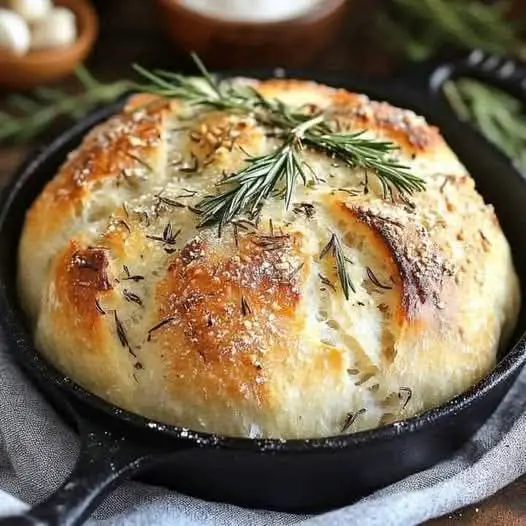Ingredients:
- 3 ½ cups all-purpose flour (plus extra for dusting)
- 1 ½ tsp salt
- 1 tsp active dry yeast
- 1 tsp sugar (for activating the yeast)
- 1 ½ cups warm water (about 110°F or 43°C)
- 2 tbsp olive oil (plus extra for drizzling)
- 2 tbsp fresh rosemary (finely chopped)
- 3-4 garlic cloves (finely chopped or minced)
- Optional: 1 tbsp honey or 1 tsp of balsamic vinegar (for a touch of sweetness)
Equipment:
- Large mixing bowl
- Large spoon or spatula for stirring
- Parchment paper (optional)
- Cast iron Dutch oven or heavy pot with lid
- Tea towel or plastic wrap
Instructions:
Step 1: Activate the Yeast
- In a small bowl, combine the warm water, sugar, and active dry yeast. Stir gently and let it sit for about 5 minutes until it becomes frothy. This indicates the yeast is activated.
Step 2: Mix the Dough
- In a large mixing bowl, combine the flour and salt.
- Add the yeast mixture (from Step 1), olive oil, rosemary, and garlic to the dry ingredients. Stir with a spoon or spatula until the dough begins to come together into a shaggy ball. If using honey or balsamic vinegar, add them here as well.
Step 3: Let the Dough Rise
- Once the dough is mixed, cover the bowl with a tea towel or plastic wrap.
- Let the dough rise at room temperature for 12-18 hours. The dough should double in size and have bubbles throughout.
Step 4: Shape the Dough
- After the dough has risen, turn it out onto a well-floured surface. It will be sticky, so be sure to dust your hands and the surface with flour.
- Gently fold the dough in on itself a few times, shaping it into a loose ball.
- Optional: If you prefer a more rustic look, you can leave the dough in a more free-form shape.
Step 5: Preheat the Oven
- Preheat your oven to 450°F (232°C).
- If you are using a Dutch oven, place it (without the lid) into the oven while it preheats. This helps to create a steamy environment for the bread.
Step 6: Bake the Bread
- Once the oven and Dutch oven are preheated, carefully remove the pot from the oven using oven mitts.
- Line the bottom of the Dutch oven with a piece of parchment paper (optional but helps with cleanup and prevents sticking).
- Carefully transfer the dough into the hot pot. You can use the parchment paper to help with this, gently lowering the dough into the pot.
- Put the lid on the Dutch oven and place it back in the oven.
- Bake the bread for 30 minutes with the lid on. After 30 minutes, remove the lid and bake for an additional 15-20 minutes until the bread is golden brown and sounds hollow when tapped on the bottom.
Step 7: Cool and Serve
- Once the bread is done, remove it from the oven and let it cool on a wire rack for at least 15-20 minutes before slicing. This ensures the texture firms up and the flavors deepen.
- Slice and serve warm, ideally with olive oil for dipping or alongside soups, salads, or any dish you’d like to complement with a flavorful bread.
Tips:
- For Extra Flavor: You can infuse the olive oil with more rosemary and garlic and drizzle it on the bread just before serving.
- Storage: Store the bread in a paper bag or wrapped in a cloth to keep the crust crispy. It should stay fresh for a couple of days. To keep it longer, freeze slices and toast as needed.
- Optional Add-Ins: You can add olives, sun-dried tomatoes, or cheese (such as parmesan or mozzarella) to the dough for added flavor.
Enjoy your rustic, no-knead rosemary garlic bread! It’s perfect for casual meals or for sharing with loved ones.
